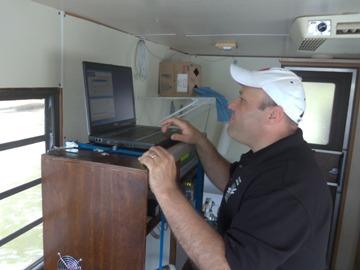
Section Branding
Header Content
Scientists Float Down Savannah River
Primary Content

Researchers are preparing to float down the Savannah River to help answer one of the river's most complex questions: Just how fast does it digest everything that flows into it?
The answer will mean costly changes in how cities and industries use water on the Savannah.
Southeastern Natural Sciences Academy researcher Oscar Flite loves science.
But there's one thing that sometimes frustrates him.
"A lot of times, research just leads to more questions," Flite says. "This has led us in this direction to actually just get in and go measure the thing."
That "thing" is the Savannah River.
And to measure it, he's standing on a houseboat about the size of a small RV.
Pumps, diodes and computers hum inside, constantly monitoring the murky water below.
"We're about to sample from a waste-water treatment plant," Flite says. "This waste-water treatment plant is from Aiken County."
The houseboat is traveling at the speed of the water.
You probably could walk faster.
But Flite says, this is the best way to find out how the river breaks down oxygen-depleting waste.
"Normally, what's done is, you go out and put a bunch of instrumentation in the water and you let the water pass you by," Flite says. "But there's another completely different way. And the idea is to stay in the same packet of water as it moves downstream."
Today is just practice.
But when Flite actually goes out, it'll take him and two colleagues 10 days to float from Augusta to near Savannah.
They'll be following water marked by a floating orange buoy.
"And at night, we put some glow sicks on it, so we can see it," Flite says.
The Environmental Protection Agency is about to impose a limit on how much oxygen-deleting waste dischargers can put in the river.
Flite's samples could confirm or modify research by federal regulators like the EPA's Bill Melville.
The limit is called the TMDL, or Total Maximum Daily Load.
"What, in effect, that is is a way to technically evaluate how much pollution you can put into a water body where it would be digested and bio-processed and still meet water quality standards," Melville says.
Melville says, everyone from farmers spreading fertilizer to city folks flushing toilets contribute to the stress on the river's health.
At the Weyerhaeuser paper mill near Savannah, about 10 million gallons of treated used water a day cascade into the river.
The mill's water chief Chris Blocker says, his goal is to make the water as healthy going out as it is going in.
"What's great about this is that state of Georgia and EPA... gave us some numbers and allowed us to divide the allocations between ourselves and come up with a plan on how we're going to meet this thing."
That makes the EPA proposal a "cap-and-trade" system.
But it will work only if the science is right.
Weyerhaeuser's top environmental officer Martin Lebo in Boston welcomes new research like Flite's.
"The data that has been collected in the river is probably not as strong as the harbor itself," Lebo says. "And so, that is an area that would most benefit from some additional data."
Weyerhaeuser has spent millions of dollars upgrading in advance of the new rules.
Two other companies with plants along the river wouldn't talk about this story.
If they haven't prepared, they'll be in for an expensive shock.
Lebo says, the point is, overall waste will go down by a dramatic 72%.
"There will be a large reduction in the total amount of material discharged through the river," Lebo says. "And that will have benefits associated with it."
Flite expects to make his slow ride down the Savannah River in June and make the data later this year.
The final EPA rules on river digestion were expected late last year.
Agency officials say, they could be released any time.
Tags: Savannah River, Environmental Protection Agency, GPB News, Oscar Flite, Martin Lebo, Chris Blocker, Bill Melville, Southeastern Natural Sciences Academy, Weyerhaeuser
